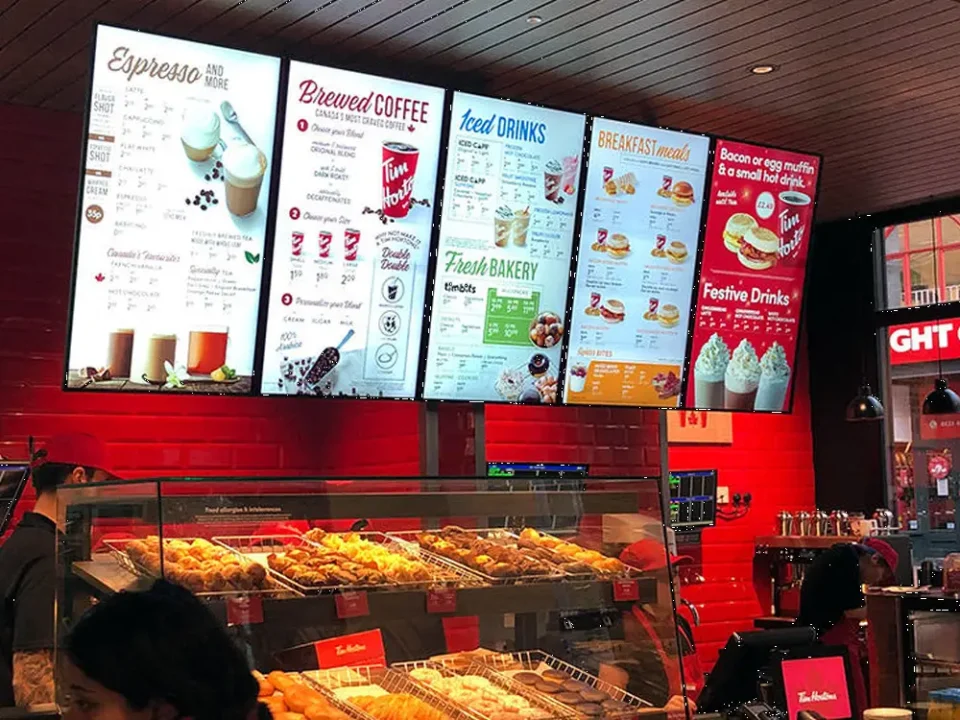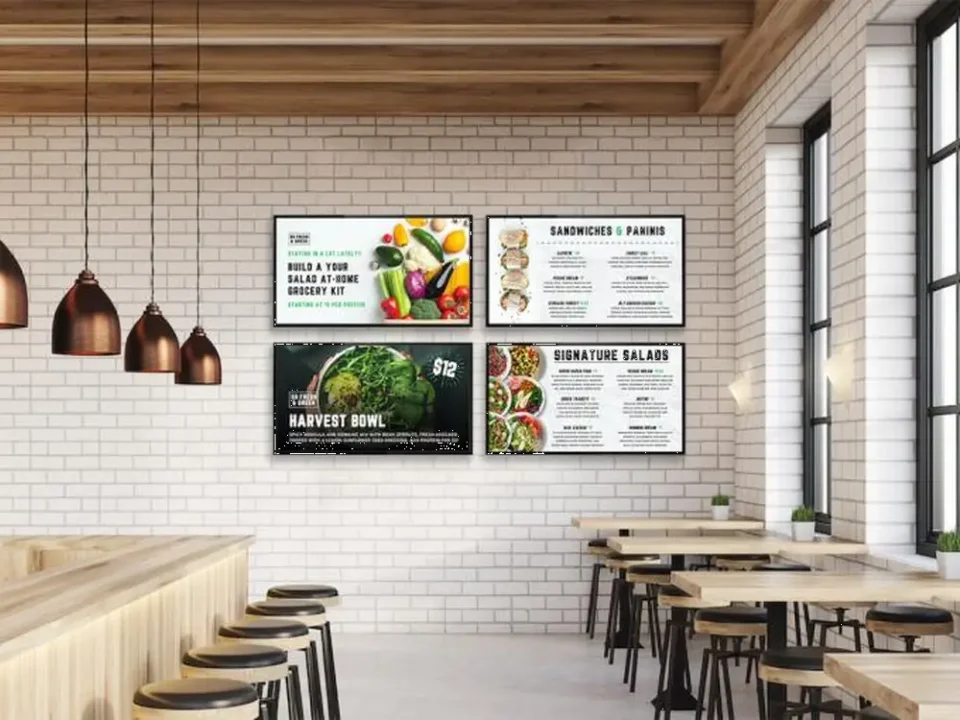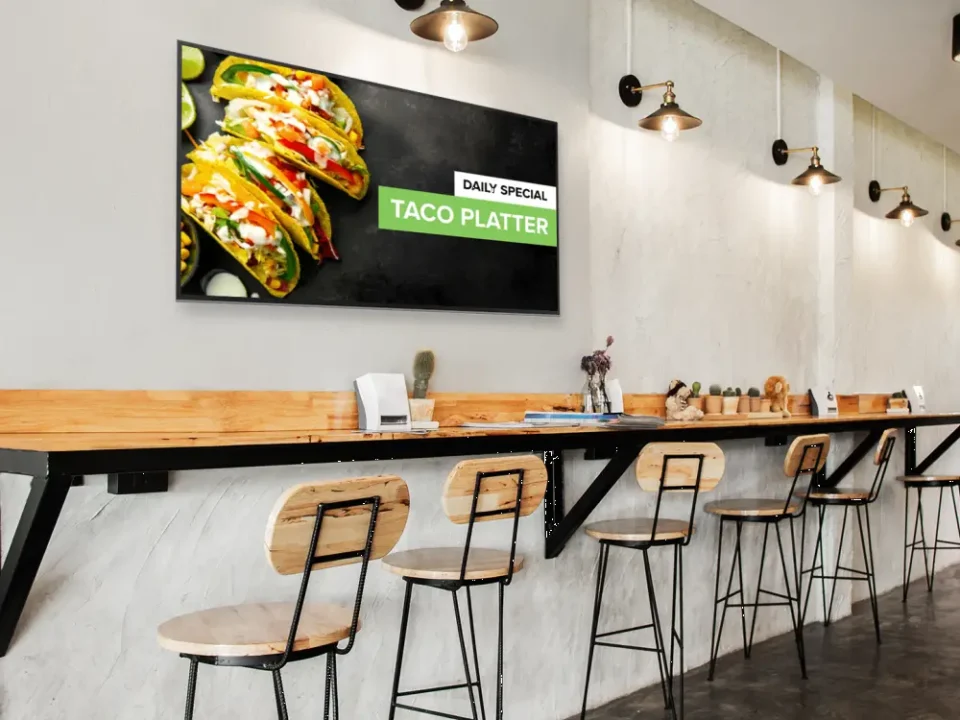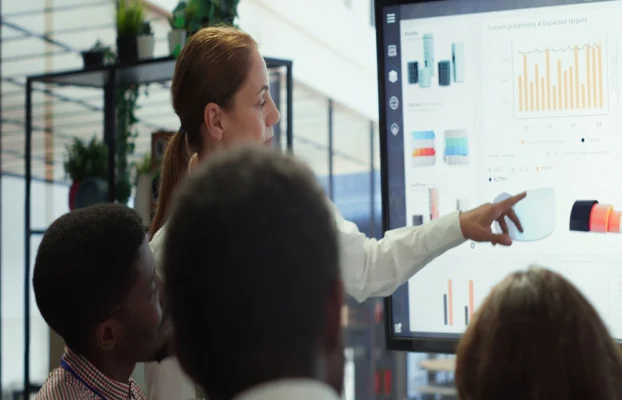In today’s fast-paced world, where technology permeates every aspect of our lives, the restaurant industry is no exception. Gone are the days of traditional static menus and posters; enter the era of dynamic digital signage. This modern approach to restaurant presentation is revolutionizing the dining experience for both customers and proprietors alike.
 Digital signage, often comprised of LED displays or LCD screens strategically placed throughout a restaurant, serves multiple purposes beyond merely displaying menu items. Let’s delve into how digital signage is transforming the restaurant landscape.
A Feast for the Eyes
First and foremost, digital signage enhances visual appeal. The vibrant, eye-catching displays draw customers’ attention, enticing them with tantalizing images of culinary creations. High-definition images of delectable dishes, coupled with engaging animations, ignite appetites and elevate anticipation.
Dynamic Content Delivery
Unlike traditional static menus, digital signage enables real-time updates and dynamic content delivery. This flexibility empowers restaurants to effortlessly showcase daily specials, seasonal offerings, and promotions. With just a few clicks, menu changes can be implemented across all screens, ensuring consistency and accuracy throughout the establishment.
Digital signage, often comprised of LED displays or LCD screens strategically placed throughout a restaurant, serves multiple purposes beyond merely displaying menu items. Let’s delve into how digital signage is transforming the restaurant landscape.
A Feast for the Eyes
First and foremost, digital signage enhances visual appeal. The vibrant, eye-catching displays draw customers’ attention, enticing them with tantalizing images of culinary creations. High-definition images of delectable dishes, coupled with engaging animations, ignite appetites and elevate anticipation.
Dynamic Content Delivery
Unlike traditional static menus, digital signage enables real-time updates and dynamic content delivery. This flexibility empowers restaurants to effortlessly showcase daily specials, seasonal offerings, and promotions. With just a few clicks, menu changes can be implemented across all screens, ensuring consistency and accuracy throughout the establishment.
 Streamlining Ordering Processes
Digital signage isn’t limited to menu displays; it can also streamline the ordering process. Interactive touch-screen kiosks allow customers to browse the menu, customize their orders, and place them directly—eliminating the need for lengthy wait times and enhancing overall efficiency. This self-service approach empowers patrons to control their dining experience while reducing pressure on waitstaff during peak hours.
Enhancing Customer Engagement
Incorporating interactive elements into digital signage fosters greater customer engagement. Games, quizzes, and surveys displayed on screens provide entertainment while patrons await their meals. Moreover, interactive displays can serve as valuable feedback channels, allowing customers to rate their dining experience or provide suggestions for improvement—an invaluable tool for restaurateurs striving to enhance service quality.
Targeted Marketing Opportunities
Digital signage presents a unique opportunity for targeted marketing. By leveraging customer data and analytics, restaurants can tailor content to specific demographics or preferences. For instance, a family-friendly restaurant might display ads for kids’ meals during peak family dining hours, while a cocktail bar could promote happy hour specials to young professionals in the evening. This targeted approach maximizes the effectiveness of marketing efforts and drives sales.
Operational Efficiency
Beyond its impact on the customer experience, digital signage improves operational efficiency behind the scenes. Integrated with restaurant management systems, digital displays can sync with inventory levels, ensuring that menu items reflect real-time availability. Additionally, digital signage can facilitate communication between kitchen staff and servers, minimizing errors and delays in order fulfillment.
Sustainability and Cost Savings
Digital signage not only benefits the bottom line but also the planet. By replacing printed menus and posters with digital displays, restaurants reduce paper waste and environmental impact. Moreover, while the initial investment in digital signage may seem substantial, the long-term cost savings—in terms of reduced printing costs and increased efficiency—often outweigh the upfront expenses.
Streamlining Ordering Processes
Digital signage isn’t limited to menu displays; it can also streamline the ordering process. Interactive touch-screen kiosks allow customers to browse the menu, customize their orders, and place them directly—eliminating the need for lengthy wait times and enhancing overall efficiency. This self-service approach empowers patrons to control their dining experience while reducing pressure on waitstaff during peak hours.
Enhancing Customer Engagement
Incorporating interactive elements into digital signage fosters greater customer engagement. Games, quizzes, and surveys displayed on screens provide entertainment while patrons await their meals. Moreover, interactive displays can serve as valuable feedback channels, allowing customers to rate their dining experience or provide suggestions for improvement—an invaluable tool for restaurateurs striving to enhance service quality.
Targeted Marketing Opportunities
Digital signage presents a unique opportunity for targeted marketing. By leveraging customer data and analytics, restaurants can tailor content to specific demographics or preferences. For instance, a family-friendly restaurant might display ads for kids’ meals during peak family dining hours, while a cocktail bar could promote happy hour specials to young professionals in the evening. This targeted approach maximizes the effectiveness of marketing efforts and drives sales.
Operational Efficiency
Beyond its impact on the customer experience, digital signage improves operational efficiency behind the scenes. Integrated with restaurant management systems, digital displays can sync with inventory levels, ensuring that menu items reflect real-time availability. Additionally, digital signage can facilitate communication between kitchen staff and servers, minimizing errors and delays in order fulfillment.
Sustainability and Cost Savings
Digital signage not only benefits the bottom line but also the planet. By replacing printed menus and posters with digital displays, restaurants reduce paper waste and environmental impact. Moreover, while the initial investment in digital signage may seem substantial, the long-term cost savings—in terms of reduced printing costs and increased efficiency—often outweigh the upfront expenses.
 Conclusion
In an increasingly digital world, embracing technology is paramount for restaurants seeking to thrive in a competitive market. Digital signage offers a myriad of benefits, from enhancing visual appeal and streamlining operations to fostering customer engagement and targeted marketing. By incorporating dynamic displays into their establishments, restaurateurs can create immersive dining experiences that leave a lasting impression on patrons. As the restaurant industry continues to evolve, digital signage remains a powerful tool for innovation and differentiation. By harnessing the capabilities of digital technology, restaurants can elevate their offerings, exceed customer expectations, and stay ahead of the curve in an ever-changing landscape.
Conclusion
In an increasingly digital world, embracing technology is paramount for restaurants seeking to thrive in a competitive market. Digital signage offers a myriad of benefits, from enhancing visual appeal and streamlining operations to fostering customer engagement and targeted marketing. By incorporating dynamic displays into their establishments, restaurateurs can create immersive dining experiences that leave a lasting impression on patrons. As the restaurant industry continues to evolve, digital signage remains a powerful tool for innovation and differentiation. By harnessing the capabilities of digital technology, restaurants can elevate their offerings, exceed customer expectations, and stay ahead of the curve in an ever-changing landscape.
 Digital signage, often comprised of LED displays or LCD screens strategically placed throughout a restaurant, serves multiple purposes beyond merely displaying menu items. Let’s delve into how digital signage is transforming the restaurant landscape.
A Feast for the Eyes
First and foremost, digital signage enhances visual appeal. The vibrant, eye-catching displays draw customers’ attention, enticing them with tantalizing images of culinary creations. High-definition images of delectable dishes, coupled with engaging animations, ignite appetites and elevate anticipation.
Dynamic Content Delivery
Unlike traditional static menus, digital signage enables real-time updates and dynamic content delivery. This flexibility empowers restaurants to effortlessly showcase daily specials, seasonal offerings, and promotions. With just a few clicks, menu changes can be implemented across all screens, ensuring consistency and accuracy throughout the establishment.
Digital signage, often comprised of LED displays or LCD screens strategically placed throughout a restaurant, serves multiple purposes beyond merely displaying menu items. Let’s delve into how digital signage is transforming the restaurant landscape.
A Feast for the Eyes
First and foremost, digital signage enhances visual appeal. The vibrant, eye-catching displays draw customers’ attention, enticing them with tantalizing images of culinary creations. High-definition images of delectable dishes, coupled with engaging animations, ignite appetites and elevate anticipation.
Dynamic Content Delivery
Unlike traditional static menus, digital signage enables real-time updates and dynamic content delivery. This flexibility empowers restaurants to effortlessly showcase daily specials, seasonal offerings, and promotions. With just a few clicks, menu changes can be implemented across all screens, ensuring consistency and accuracy throughout the establishment.
 Streamlining Ordering Processes
Digital signage isn’t limited to menu displays; it can also streamline the ordering process. Interactive touch-screen kiosks allow customers to browse the menu, customize their orders, and place them directly—eliminating the need for lengthy wait times and enhancing overall efficiency. This self-service approach empowers patrons to control their dining experience while reducing pressure on waitstaff during peak hours.
Enhancing Customer Engagement
Incorporating interactive elements into digital signage fosters greater customer engagement. Games, quizzes, and surveys displayed on screens provide entertainment while patrons await their meals. Moreover, interactive displays can serve as valuable feedback channels, allowing customers to rate their dining experience or provide suggestions for improvement—an invaluable tool for restaurateurs striving to enhance service quality.
Targeted Marketing Opportunities
Digital signage presents a unique opportunity for targeted marketing. By leveraging customer data and analytics, restaurants can tailor content to specific demographics or preferences. For instance, a family-friendly restaurant might display ads for kids’ meals during peak family dining hours, while a cocktail bar could promote happy hour specials to young professionals in the evening. This targeted approach maximizes the effectiveness of marketing efforts and drives sales.
Operational Efficiency
Beyond its impact on the customer experience, digital signage improves operational efficiency behind the scenes. Integrated with restaurant management systems, digital displays can sync with inventory levels, ensuring that menu items reflect real-time availability. Additionally, digital signage can facilitate communication between kitchen staff and servers, minimizing errors and delays in order fulfillment.
Sustainability and Cost Savings
Digital signage not only benefits the bottom line but also the planet. By replacing printed menus and posters with digital displays, restaurants reduce paper waste and environmental impact. Moreover, while the initial investment in digital signage may seem substantial, the long-term cost savings—in terms of reduced printing costs and increased efficiency—often outweigh the upfront expenses.
Streamlining Ordering Processes
Digital signage isn’t limited to menu displays; it can also streamline the ordering process. Interactive touch-screen kiosks allow customers to browse the menu, customize their orders, and place them directly—eliminating the need for lengthy wait times and enhancing overall efficiency. This self-service approach empowers patrons to control their dining experience while reducing pressure on waitstaff during peak hours.
Enhancing Customer Engagement
Incorporating interactive elements into digital signage fosters greater customer engagement. Games, quizzes, and surveys displayed on screens provide entertainment while patrons await their meals. Moreover, interactive displays can serve as valuable feedback channels, allowing customers to rate their dining experience or provide suggestions for improvement—an invaluable tool for restaurateurs striving to enhance service quality.
Targeted Marketing Opportunities
Digital signage presents a unique opportunity for targeted marketing. By leveraging customer data and analytics, restaurants can tailor content to specific demographics or preferences. For instance, a family-friendly restaurant might display ads for kids’ meals during peak family dining hours, while a cocktail bar could promote happy hour specials to young professionals in the evening. This targeted approach maximizes the effectiveness of marketing efforts and drives sales.
Operational Efficiency
Beyond its impact on the customer experience, digital signage improves operational efficiency behind the scenes. Integrated with restaurant management systems, digital displays can sync with inventory levels, ensuring that menu items reflect real-time availability. Additionally, digital signage can facilitate communication between kitchen staff and servers, minimizing errors and delays in order fulfillment.
Sustainability and Cost Savings
Digital signage not only benefits the bottom line but also the planet. By replacing printed menus and posters with digital displays, restaurants reduce paper waste and environmental impact. Moreover, while the initial investment in digital signage may seem substantial, the long-term cost savings—in terms of reduced printing costs and increased efficiency—often outweigh the upfront expenses.
 Conclusion
In an increasingly digital world, embracing technology is paramount for restaurants seeking to thrive in a competitive market. Digital signage offers a myriad of benefits, from enhancing visual appeal and streamlining operations to fostering customer engagement and targeted marketing. By incorporating dynamic displays into their establishments, restaurateurs can create immersive dining experiences that leave a lasting impression on patrons. As the restaurant industry continues to evolve, digital signage remains a powerful tool for innovation and differentiation. By harnessing the capabilities of digital technology, restaurants can elevate their offerings, exceed customer expectations, and stay ahead of the curve in an ever-changing landscape.
Conclusion
In an increasingly digital world, embracing technology is paramount for restaurants seeking to thrive in a competitive market. Digital signage offers a myriad of benefits, from enhancing visual appeal and streamlining operations to fostering customer engagement and targeted marketing. By incorporating dynamic displays into their establishments, restaurateurs can create immersive dining experiences that leave a lasting impression on patrons. As the restaurant industry continues to evolve, digital signage remains a powerful tool for innovation and differentiation. By harnessing the capabilities of digital technology, restaurants can elevate their offerings, exceed customer expectations, and stay ahead of the curve in an ever-changing landscape.






